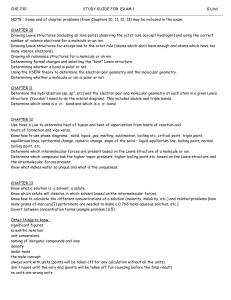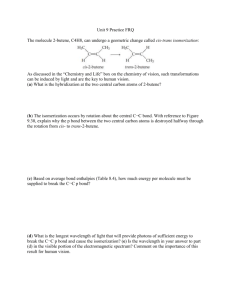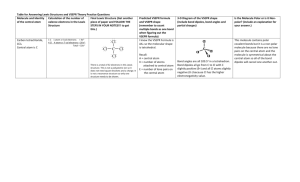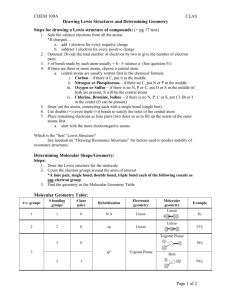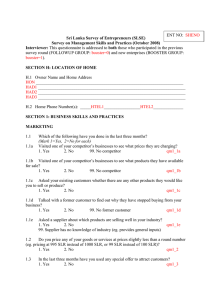Chem 126A
advertisement
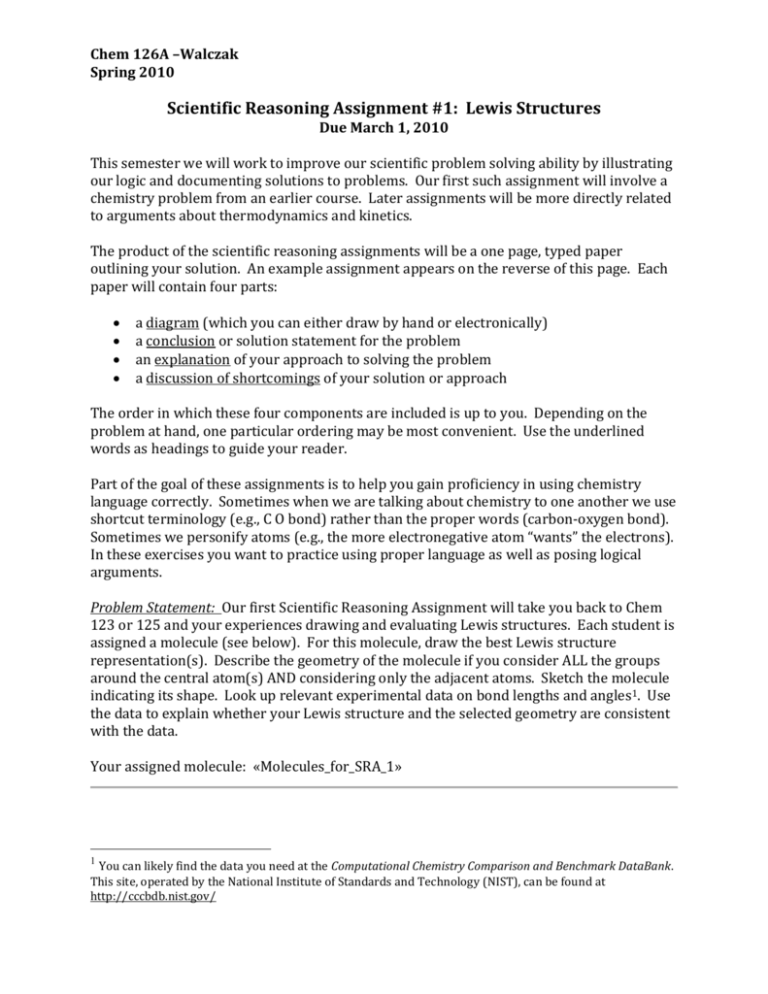
Chem 126A –Walczak Spring 2010 Scientific Reasoning Assignment #1: Lewis Structures Due March 1, 2010 This semester we will work to improve our scientific problem solving ability by illustrating our logic and documenting solutions to problems. Our first such assignment will involve a chemistry problem from an earlier course. Later assignments will be more directly related to arguments about thermodynamics and kinetics. The product of the scientific reasoning assignments will be a one page, typed paper outlining your solution. An example assignment appears on the reverse of this page. Each paper will contain four parts: a diagram (which you can either draw by hand or electronically) a conclusion or solution statement for the problem an explanation of your approach to solving the problem a discussion of shortcomings of your solution or approach The order in which these four components are included is up to you. Depending on the problem at hand, one particular ordering may be most convenient. Use the underlined words as headings to guide your reader. Part of the goal of these assignments is to help you gain proficiency in using chemistry language correctly. Sometimes when we are talking about chemistry to one another we use shortcut terminology (e.g., C O bond) rather than the proper words (carbon-oxygen bond). Sometimes we personify atoms (e.g., the more electronegative atom “wants” the electrons). In these exercises you want to practice using proper language as well as posing logical arguments. Problem Statement: Our first Scientific Reasoning Assignment will take you back to Chem 123 or 125 and your experiences drawing and evaluating Lewis structures. Each student is assigned a molecule (see below). For this molecule, draw the best Lewis structure representation(s). Describe the geometry of the molecule if you consider ALL the groups around the central atom(s) AND considering only the adjacent atoms. Sketch the molecule indicating its shape. Look up relevant experimental data on bond lengths and angles1. Use the data to explain whether your Lewis structure and the selected geometry are consistent with the data. Your assigned molecule: «Molecules_for_SRA_1» 1 You can likely find the data you need at the Computational Chemistry Comparison and Benchmark DataBank. This site, operated by the National Institute of Standards and Technology (NIST), can be found at http://cccbdb.nist.gov/ Problem Statement: Draw the best Lewis structure representation for SO 2 (S is central). Describe the geometry around the sulfur atom if you consider ALL the groups around the central atom AND considering only the O atoms. Sketch the molecule indicating its shape. Look up relevant experimental data. Use the data to explain whether your Lewis structure and the selected geometry are consistent with the data. Diagram: Lewis Structures: O S O S O + - - Geometry: O + O S O S O O Explanation: Sulfur dioxide has 18 valence electrons (6 from each O and 6 from the S). Three Lewis structures are possible, as shown in the diagram. The top structure has zero formal charge on each atom. The other two structures have a positive formal charge on sulfur and a negative formal charge on one of the oxygen atoms. There are three groups of electrons around the central sulfur atom. Since three groups of electrons can maximize their distance by adopting a trigonal planar structure, the overall geometry is trigonal planar. If only the atoms are considered (since we can’t “see” the unshared pair of electrons), the geometry is bent. In SO2: S-O 143.2 pm Comparison data: S=O 141.8-144.3 pm ∠OSO 119.5˚ S-O 151.0-157.4 pm Source: Computational Chemistry Comparison and Benchmark DataBank, National Institute of Standards and Technology, http://cccbdb.nist.gov/ accessed 2/5/2010. The data in the box above provide the values for the S-O bond length (143.2 pm) and the OSO bond angle (119.5˚). The fact that there is only one S-O bond length listed indicates that the bonding to each oxygen is the same. The angle is consistent with trigonal planar geometry, which has an ideal bond angle of 120˚. This angle is slightly less due to the unshared pair of electrons on the sulfur. The other bond lengths provided above indicate that the S-O bond length in SO2 is comparable to a double bond and not a single bond. This indicates that the resonance structures with alternating single and double bonds are not a good representation of sulfur dioxide. Conclusion: The best Lewis structure in this case includes double bonds to both oxygen atoms. Although this structure violates the octet rule, sulfur is a period 3 atoms and can thus have an expanded octet. Shortcomings: The data obtained from the NIST website for comparison is from a variety of different sulfur and oxygen containing molecules. Some of the other atoms or groups in the molecule may influence the length of the S-O bond in ways that are different than for SO2. Molecules for SRA #1 N2O (N central) BF3 (B central) ClO2 (Cl central) C2N2 (cyanogens) CS2 OCS C3H4 (allene) C2F4 (tetrafluoroethene) C2H3Br (vinyl bromide) ClNO2 (N central) ClON (N central) NF3 NH3 N2F2 (Difluorodiazene) F3NO (N central) N2H4 (hydrazine) HNO (N central) HN3 (hydrogen azide) N2O4 HNO2 (H attached to one O, N central) N2 O HNO3 (H attached to one O, N central) H2O2 H2O H2SO4 (Hs attached to Os, S central) O3 PCl3 PCl5 PF3 PF5 PH3 PO2 SCl2 (S central) S2Cl (S central) SOCl2

